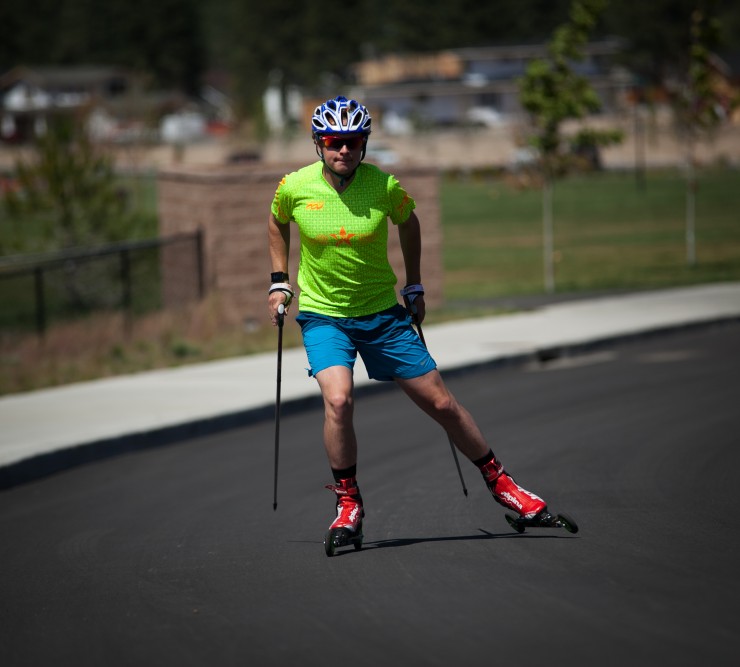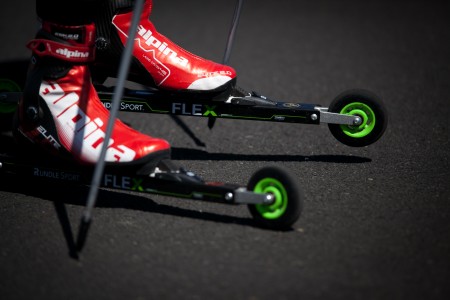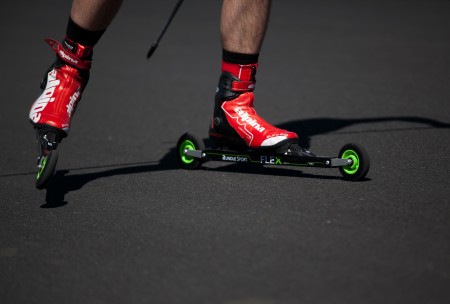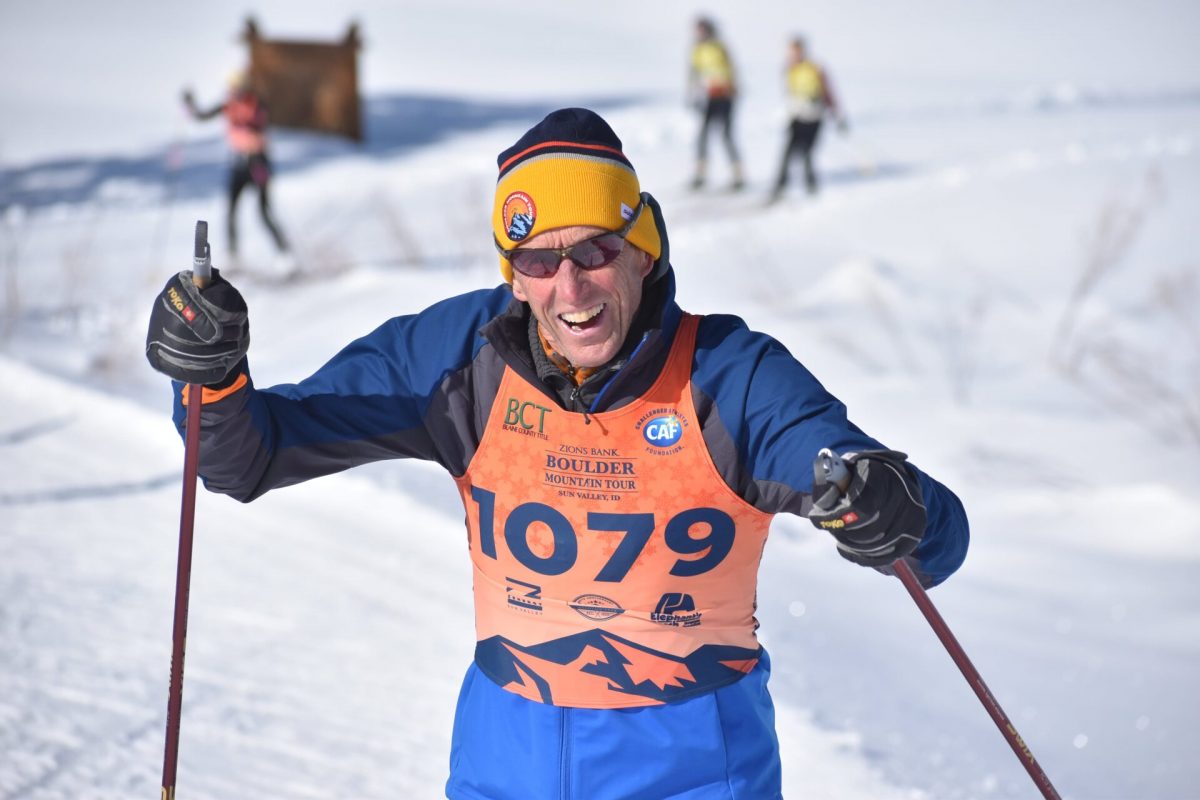
Let’s face it, rollerskiing lacks the romanticism of skating or striding through just about any type of snow-covered terrain. But if you’re serious about maintaining in-season ski specific form, it’s pretty much a must these days. Add to that list the cadre of masters skiers who suffer joint pain when running and you’ve got a steady population of skiers who rollerski during the no-snow months.
This past March, while covering the Ski Tour Canada in Canmore, Alberta, I poked around the gear booths for a few moments. Catching my eye were two items of note: FIS Cross Country sponsor Le Gruyère — you know them from those big cheese wheels skiers receive on the podium — had a booth with tasty samples. And Canmore-based Rundle Sport displayed their snazzy rollerskis.
Rundle Sport’s higher-end rollerskis, the FLEX models, use what they call TrueSki Technology. (Built-in rollerski suspensions are not new, different companies have experimented with the concept, with some products having been brought to market). In simple terms, the proprietary technology is a clever combo of rubber dampeners and pivoting forks to create a suspension system. Basically, you should be thinking mini-shock absorbers when you hear suspension system. Otherwise the Rundle Sport rollerskis use a traditional aluminum shaft with pre-drilled holes making SNS/Prolink, NIS and NNN binding mounts a breeze.
If you happen to live in a community where butter-smooth pavement is plentiful and the words “chip and seal” sound more like a Ben and Jerry’s ice cream mash-up, then the idea of a rollerski with suspension may seem like overkill. But in places like Bend, Ore., where this reviewer lives, smooth pavement is scarce. A few out-and-back runs of blissfully smooth asphalt remain, but chip and seal are king. The city and county have been resurfacing roads with the bumpy mix for several years now. If linking up roads to create longer loops in town are on your agenda, the vibrations poor-quality pavement jolt through the rollerski and into your foot can be a deal breaker. That’s the first reason I checked out Rundle Sport’s Flex series after getting my Le Gruyère cheese fix in Canmore.
Rundle Sport makes three claims about their TrueSki technology: it reduces vibration, mimics skiing on snow and their skis are more durable. Let’s take those claims in order.
Vibration reduction:
This is where Rundle Sport’s FLEX Skate Rollerskis shine. Bert Hinkley, one of the godfathers of nordic sport here in town, and I tested out several pairs of rollerskis on both vibration-inducing pavement and the smoothest section of asphalt pretty much between Bend and the Pacific Ocean. We tried all sorts of combinations — straight-up aluminum shaft ski on one foot, FLEX on the other, hi-tech composite ski, FLEX on the other, and even two FLEX skis set up with different dampeners. More on that in a bit.

Want a smoother ride? In other words, less vibration, use the FLEX ski. It was that obvious. What I am describing is not a complete elimination of vibration or road noise, but a dampening of those vibrations.
Both Hinkley and I discussed road noise as if it were a sound wave with a discernible frequency and amplitude. If the frequency and amplitude of the waves were greater with the aluminum and composite shaft skis (read more chatter), they were mellowed considerably with the FLEX ski.
Do the FLEX skis reduce vibration? A straight-up yup!
Rundle Sport also claims it will tailor the FLEX rollerski suspension to a skier’s weight. The dampeners, part of the suspension system, come in a range of densities that are color coded. For example, the black dampeners are extra stiff, for skiers 80 kilograms (176 pounds) or more. (It takes about ten minutes using an allen wrench to swap out the four dampeners per pair.)
Rundle Sport sent the entire range of dampers, from extra stiff to extra soft. I began the test with red dampeners (medium 60-69 kg) in both skis. I tilt the scales around 68 kg — so in theory, a good fit for my weight. Just to test out what a softer flex might feel like, after skiing several days with the red dampeners, I set one ski up with orange dampeners (soft 50-59 kg), for comparison.
In our side-by-side tests, all of the above observations comparing the FLEX skis to the composite and aluminum skis hold true for both the medium and soft suspensions. (Hinkley and I are the same weight.) The only discernible difference in terms of vibration between the two different FLEX set ups was that the softer dampeners reduced road noise a bit more. If I had to choose between the two on rougher roads, I’d pick the softer set up.
This brings us to Rundle Sport’s second claim: “TrueSki rollerskis mimic skiing on snow”.
On-Snow Feel
First off, we are talking rollerskis on pavement. Undoubtedly any road surface is harder, hotter and less forgiving than snow. (I’m not throwing ice into the snow-crystal matrix.) An on-snow feel in this reviewer’s eyes seems like a dicey claim that many rollerski manufacturers make. Here’s what I will say, the FLEX rollerskis do flex — the vibration-reducing suspension flexes in the front and rear of the ski — kind of like a skate ski during the loading and push off phase on snow.

Given the same weight skier, the flex is more noticeable using the soft dampener compared to the medium dampener. This reviewer liked slightly more flex. Hinkley on the other hand would choose the stiffer setup.
“I liked the softer elastomer for vibration. I think if I were going to ski on one pair, I would use the elastomer suited to my weight,” Hinkley said. “It still reduced vibration but at the same time it gave me more feedback and more transmission of power. I just felt like if I wanted to step it up, and do some sprinting, or if I really wanted to step it up and hammer hard up a hill, then I wasn’t losing energy pushing against a softer elastomer.”
Another tester, Mount Bachelor Ski Education Foundation skier Lydia Youkey took the FLEX skis out for a spin. Her impressions left nothing up to interpretation. “The rollerskis were AWESOME,” Youkey wrote. “They really skied smoothly over rough roads, and felt much more like skiing on-snow than the aluminum rollerskis I’m used to. They had a sort of bounce that simulated the flex of a ski … I didn’t want to give them back :).”
This much is worth mentioning, prior to my use of the FLEX rollerskis, I’d never really thought about how stiff my rollerskis were. I’ve heard folks talk about skate rollerskis flexing, but for me — not exactly hummingbird light and not clydesdale class — my composite rollerskis feel stiff and responsive. If I have a complaint other than their considerable “noisiness” compared to the FLEX skis, I now would consider my rollerskis too responsive.
Ultimately, does the FLEX ski mimic skiing on snow? It’s real close. But again, I’m a realist, there’s no denying I’m rollerskiing on pavement in Oregon’s high desert — not skiing on snow.
If you live in a place with deteriorating pavement, the FLEX rollerski may be your best option.
An on-snow feel in this reviewer’s eyes seems like a dicey claim that many rollerski manufacturers make. Here’s what I will say, the FLEX rollerskis do flex … kind of like a skate ski during the loading and push off phase on snow.
Durability
Any comments about general durability are beyond the scope of this review. We simply have not used the FLEX rollerskis long enough to make any claims about the product’s longevity. Rundle Sport has a lifetime warranty, which in this day and age is a statement in terms of product support. Here’s the warranty language posted on Rundle Sport’s website:
“FLEX rollerskis carry a lifetime original owner warranty. Excluding wheel wear, Rundle Sport will repair or replace any part which under normal service proves defective in material or workmanship. The claimed defective product must be returned to Rundle Sport Inc. The warranty applies for the original owner and only if the skier weighs less than 95kg.”
Unless you are shuttling, what goes up, must come down. The only minor complaint Hinkley and I had regarding the FLEX rollerski was that it had a tendency to “wander” slightly while descending at high speeds. The composite and non-FLEX aluminum skis tracked a bit straighter. I returned several times to a long bombing descent and found I simply had to have a degree more focus while descending on the FLEX skis. Nothing scary, just more mindful of the ski under foot.
FLEX Skate Rollerski specs:
Price: $307.51 (US Dollars)
Wheel size: Standard Wheel Size (100x24mm)
Binding used for product review: Salomon Prolink
Website: rundlesport.com
Jason Albert
Jason lives in Bend, Ore., and can often be seen chasing his two boys around town. He’s a self-proclaimed audio geek. That all started back in the early 1990s when he convinced a naive public radio editor he should report a story from Alaska’s, Ruth Gorge. Now, Jason’s common companion is his field-recording gear.



